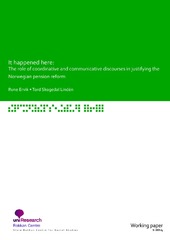| dc.contributor.author | Ervik, Rune | eng |
| dc.contributor.author | Lindén, Tord Skogedal | eng |
| dc.date.accessioned | 2015-01-30T10:22:23Z | |
| dc.date.accessioned | 2020-12-10T06:34:23Z | |
| dc.date.available | 2015-01-30T10:22:23Z | |
| dc.date.available | 2020-12-10T06:34:23Z | |
| dc.date.issued | 2014-03 | eng |
| dc.identifier.issn | 1503-0946 | |
| dc.identifier.uri | https://hdl.handle.net/1956/9308 | |
| dc.description.abstract | Reasoning from the retrenchment literature (e.g. Pierson 2001) Norway should be an unlikely candidate for a major structural pension reform, because of its unique economic situation, with a steadily growing petroleum fund and substantial streams of tax revenues flowing into the public coffers. Within this context politicians should have a hard time convincing the electorate and strong interest groups such as unions of the need to reform. Still it happened here, and reform justifications met with surprisingly little and short lasting opposition. This working paper asks how reform was possible in this context, and argues that two images of justification and presentation in the Norwegian pension reform process partly explain how reform resistance was overcome. We discuss how reform advocates in different phases of the pension reform relied on two contrasting images: the first one applied to create an understanding of the need to reform, a sort of crisis scenario neatly cached in the «shark jaw» image. The shark jaw arises in a graphic illustration when projected future petroleum revenues and pension expenses are displayed simultaneously. The lines for the two indicators go in opposite directions, forming a jaw. The other image consisted in framing the actual reform as an improvement; this is contained in the «elevator» image. This is a policy story of progress, in terms of how the reform lets you enter an elevator that brings you upwards, starkly contrasting and contradicting the substance of retrenchment, in which benefits and replacement levels are reduced. The point of the elevator metaphor is that future pensions will secure a high standard of living even though public pensions (the elevator) do not bring you to the top floor. We argue that the shark jaw summarises and was important in a coordinative discourse at the elite level/directed towards the elite, whereas the elevator metaphor catches the essence of the arguments towards the wider population. The images of the shark jaw and the elevator are used here as pointers and headings for broader policy stories, containing other important elements and indicators as will be revealed. Our paper is informed by the discursive‐institutionalism perspective of Schmidt (2000, 2008, 2011) and her distinction between coordinative and communicative discourses. Empirically, we rely on a comprehensive material including document analysis, parliamentary debates, interviews with key actors in the reform process, media searches and opinion surveys. | en_US |
| dc.description.abstract | Ifølgje litteraturen om nedskjeringar, til dømes Pierson (2001), skulle ein ikkje vente ein omfattande pensjonsreform i Noreg grunna landet sin unike økonomiske situasjon med eit stort oljefond og høge skatteinntekter. I ein slik kontekst spår litteraturen at det skal vere vanskeleg å overtyde veljarar og sterke interesseorganisasjonar som fagforeiningar om behovet for reform. Likevel vart ein reform gjennomført, og grunngjevingane møtte overraskande liten og kortvarig motstand. I dette notatet spør vi korleis reform var mogleg i ein slik kontekst, og hevder at to rettferdiggjerande bilete delvis kan forklare korleis ein overvann reformmotstanden. Vi diskuterer korleis reformtilhengarar i ulike fasar av pensjonsreforma støtta seg på desse to ulike bileta: det første vart nytta for å skapa forståing for behovet for reform, eit slags krise scenario som vert godt illustrert av «haikjeften». Haikjeften er ein grafisk illustrasjon som kjem til uttrykk ved at framtidige oljeinntekter og pensjonsutgifter vert framstilt samstundes. Linene for dei to indikatorane går i motsett retning og formar ein kjeft. Det andre biletet rammar reforma inn som ei forbetring; og dette kjem til uttrykk i «heis»‐biletet. Dette er ei forteljing om framsteg, og korleis reform er ein heis som tek deg opp i sterk kontrast til nedskjeringar kor ytingar og kompensasjonsnivå tek deg nedover. Poenget med heismetaforen er at framtidige pensjonar vil sikre ein høg levestandard jamvel om offentlege pensjonar (heisen) ikkje tek deg til toppetasjen. Vi hevdar at haikjeften samanfattar og var viktig i ein koordinerande diskurs innafor elitenivået/retta mot eliten medan heismetaforen grip argumentasjonen retta mot befolkninga elles. Haikjeften og heismetaforen vert her nytta som illustrasjonar for ei brei forteljing som inneheld fleire element og indikatorar. Notatet byggjer på Schmidts (2000, 2008, 2011) diskurs‐institusjonelle perspektiv og hennar skilje mellom koordinerande og kommunikative diskurs. Det empiriske materialet omfattar ekspertintervju med sentrale aktørar i pensjonsreformprosessen, dokumentanalyse, Stortingsdebattar, mediesøk og spørjeundersøkingar. | en_US |
| dc.language.iso | eng | eng |
| dc.publisher | Stein Rokkan Centre for Social Studies | eng |
| dc.relation.ispartofseries | Working paper; 1-2014 | en_US |
| dc.title | It happened here: The role of coordinative and communicative discourses in justifying the Norwegian pension reform | eng |
| dc.type | Working paper | eng |
| dc.rights.holder | Copyright Stein Rokkan Centre for Social Studies. All rights reserved | |
| dc.description.version | publishedVersion | |
| dc.identifier.cristin | 1129591 | |
| dc.relation.project | 210442 (Norges forskningsråd) | |
